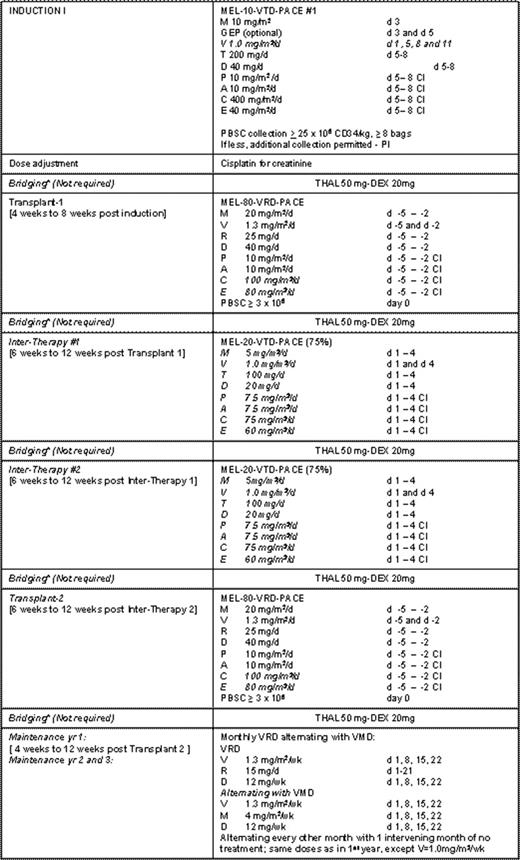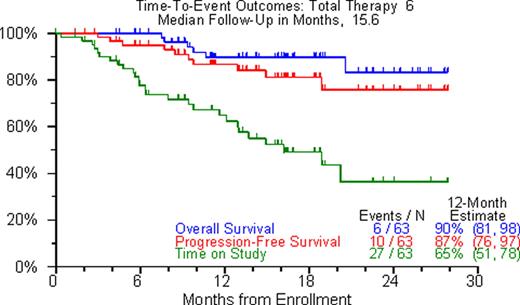Abstract
Abstract 3081
We have reported extensively on applying dose-intense total therapy approach in newly diagnosed multiple myeloma (MM), yielding long CR durations in ∼80% GEP-defined low-risk myeloma patients. Herein, we present for the first time the initial results of a phase II trial employing a dose-dense approach in previously treated MM. Patients & Methods: Patients received 5 cycles of combination chemotherapy (Figure 1) followed by maintenance with bortezomib, lenalidomide and dexamethasone until relapse or disease progression by IMWG 2006 criteria. Overall survival and progression free survival were estimated using the Kaplan-Meier method. Survival distributions were compared using the log-rank test. Results: 63 patients with previously treated MM were enrolled. The median follow-up from enrollment was 15.6 months. Baseline characteristics included age >=65yr in 37%, ISS stage II/III was seen in 41%/19% of patients, cytogenetic abnormalities (CA) in 37%, and GEP-70 high risk-MM (HRMM) in 26% of patients with available gene expression data. 11 patients (17%) had >2 prior lines of therapy including regimens that contained bortezomib (91%), thalidomide(45%), lenalidomide(81%), melphalan(27%) and steroids(100%). 14 patients (22%) discontinued therapy primarily due to progression, death or toxicity. Cumulative incidence of PR/VGPR/CR at 18 months was 69.4%, 54.8% and 37.0% respectively. Of the 60 patients with at least 3 months of follow-up, 33% had stable disease as the best overall response. The time to achieving PR or better at 6 months was more rapid in HR-MM vs LRMM (63.6% vs. 50%, p=0.008). Hematologic toxicities occurred in all patients (100%), whereas the most common non-hematologic toxicities counting all toxicities (>grades 3) included metabolic/electrolyte disturbances (95%) followed by infections (31%), hepatobiliary (20%) and gastrointestinal (16%) toxicities. Overall survival (OS) and progression free survival (PFS) at 12 months was 90% and 87%, respectively (Figure 2). The OS (96% vs 60%, p=0.0002) and PFS (92% vs 53%, p<0.0001) at 12 months was markedly superior in GEP-70 defined low-risk MM (LRMM) compared with high-risk MM (HRMM). ISS staging and GEP-defined p53 deletion did not impact OS/PFS at 12 months. Conclusions: Dose-dense strategy is highly effective in previously treated LRMM. Even though time to achieving best response was quicker in HRMM, response duration was shorter thus augmenting the significance of sustaining best response rather than depth of response in HR-MM.
Treatment Schema
Overall Survival, Progression Free Survival and Time on Study
Overall Survival, Progression Free Survival and Time on Study
No relevant conflicts of interest to declare.
Author notes
Asterisk with author names denotes non-ASH members.



This feature is available to Subscribers Only
Sign In or Create an Account Close Modal